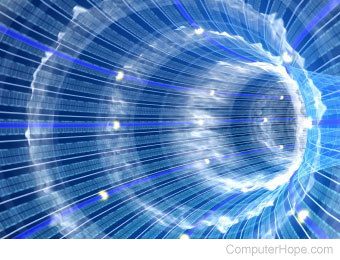Broadband

Broadband is a telecommunications technology that provides high-speed Internet access using multiple channels of simultaneous digital signals. Broadband may transmit on a wired connection using coaxial, fiber optic, twisted-pair cable, or wirelessly on a cellular network.
Broadband is also known as high-speed Internet or wideband transmission and sometimes abbreviated as BB.
Broadband was featured as a top term of 2000.
How do computers connect to broadband?
Computers in a home or office can connect to broadband using a wired connection or wireless connection. However, before being able to do either, a network router must be purchased or rented from the ISP (Internet service provider). The router is what allows your LAN (local area network) computers to communicate with the Internet.
Once a router is connected to the Internet, the home or office computers connect to the router. For a wired connection, a computer often uses a Cat 5 Ethernet cable that connects from the router to the network card in the computer. For a wireless connection, the router must be a wireless router and be set up with a known SSID (service set identifier). Once the router is set up, a computer with a wireless network, smartphone, or another device with Wi-Fi capabilities can connect to the routers SSID.
Why get broadband?
A broadband Internet connection offers a faster, more enjoyable Internet experience than a dial-up connection. With the speedier Internet connection, web pages open quickly, downloads are completed faster, and watching videos over the Internet is possible.
Broadband users can also share their connection between multiple computers and devices in their home. For example, a router or modem with Wi-Fi capability can share one broadband connection with all computers, smartphones, and any other Wi-Fi-enabled device in the home.
Finally, unlike a dial-up connection that's only connected after dialing a number and connecting to another computer, broadband is always connected.
Types of broadband
Today, there are a wide variety of broadband technologies and options available. However, not all of the following broadband services may be available for your home or office location. When looking to get broadband, you may need to visit the company's website to check for availability. If the broadband service you're looking for is not available, alternative high-speed Internet services, such as those listed below, might be.
Wi-Fi is often confused as a broadband solution. However, it's a technology that allows a wireless device to connect to any of the following broadband solutions using a router or modem with Wi-Fi capabilities. See our Wi-Fi page for further information about this technology.
Cable Internet
Cable Internet is a popular service in many parts of the world that offers high-speed Internet access over the same lines used for cable TV. Cable is an asymmetrical connection, which means it has slower upload speeds compared to its download speeds.
Cellular network
The 3G, 4G, 5G, or LTE (Long-Term Evolution) network available through your smartphone's data plan is also a broadband network. To use your desktop computer or laptop with a cellular network, you can tether your smartphone to create a Wi-Fi hotspot. Once the hotspot is created, any device with Wi-Fi can use the hotspot to connect to the Internet.
Not all carriers allow you to tether your phone. When sharing your smartphone as a hotspot, realize that the data plan can easily be exceeded. For example, if your data plan only offers 10 GB of hotspot or tethering data, and you exceed that limit, your account may incur additional charges.
DSL (digital subscriber line)
DSL (digital subscriber line) is a widely-available broadband option that uses the same wires as a landline telephone. However, because these wires are copper, it's often the slowest broadband option.
FTTP (fiber to the premises)
FTTP (fiber to the premises) is the fastest available broadband and is symmetrical, but it's only available in a limited area. With this type of broadband connection, a fiber optic cable must connect to your home or office.
Fixed wireless
A fixed wireless connection uses dish-shaped antennas to communicate over short distances to a central office or tower to provide a broadband connection. This option can offer a decent broadband connection for areas without any obstructions and within range of the provider.
Satellite
A satellite broadband option can offer broadband Internet to all parts of the world and are often the only solution for people who are in remote areas. Unfortunately, because of the added time to send and receive data from a satellite, this solution has higher latency and is a slower broadband option.
Costs of broadband
The following table is a short listing of some services and companies that provide broadband connections. The actual services available in your area may vary.
| Type | Carriers | Cost |
|---|---|---|
| Cable | Comcast Xfinity, Spectrum (formerly Time Warner Cable) | $40.00 - $200.00 |
| DSL | AT&T DSL, Verizon DSL | $15.00 - $40.00 |
| Fiber | Google Fiber, Verizon FiOS, AT&T Fiber | $70.00 - $200.00 |
| Satellite | HughesNet, Starlink, WildBlueDish | $50.00 - $150.00 |
BB, BPL, Broadband cap, Bundled service, Computer abbreviations, Internet terms, ISDN, Network terms, Phone terms, Wideband
